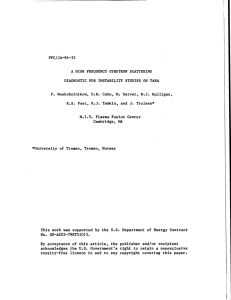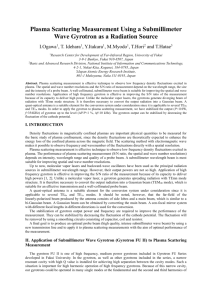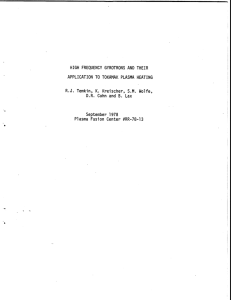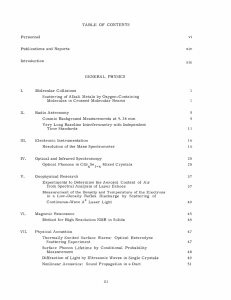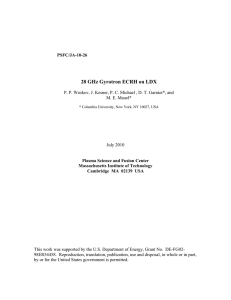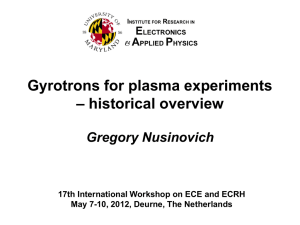PFC/JA-85-11 A PLASMA and P. Woskoboinikow
advertisement
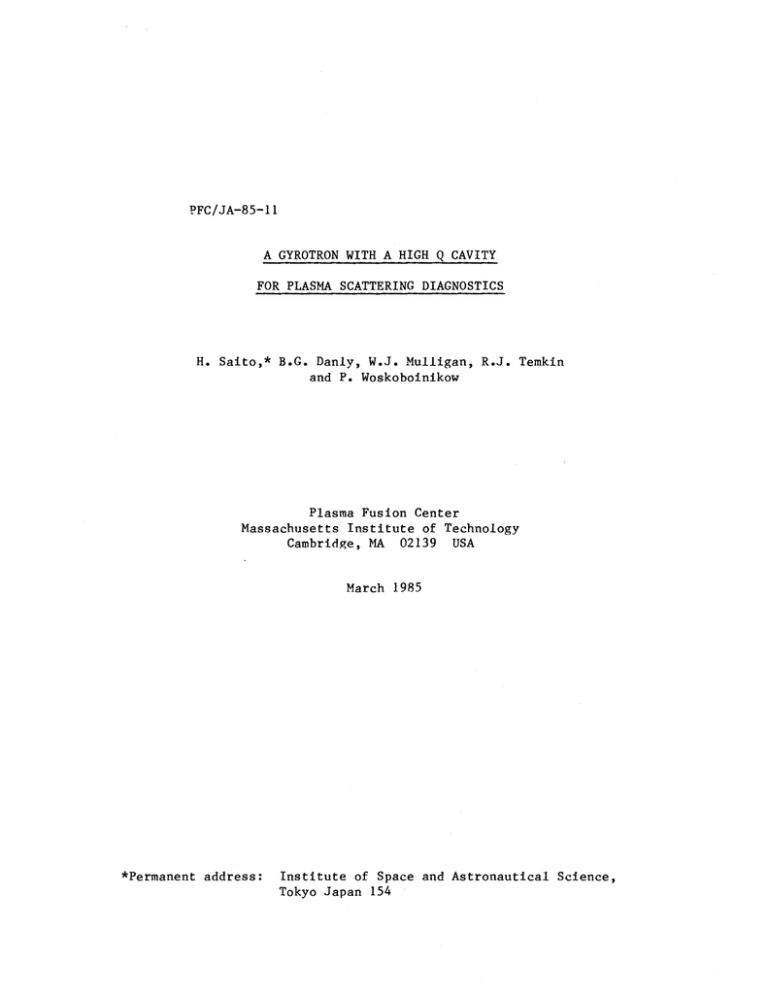
PFC/JA-85-11 A GYROTRON WITH A HIGH Q CAVITY FOR PLASMA SCATTERING DIAGNOSTICS H. Saito,* B.G. Danly, W.J. Mulligan, R.J. Temkin and P. Woskoboinikow Plasma Fusion Center Massachusetts Institute of Technology Cambridge, MA 02139 USA March 1985 *Permanent address: Institute of Space and Astronautical Science, Tokyo Japan 154 1 ABSTRACT A 137 GHz gyrotron with a high Q (- 6000) cavity has been built and tested in short pulse operation. Output power of 0.1 to 20 kW and efficiency of up to 26% were observed in 65 kV, 0.03 to 1.4 A operation in the TE 0 3 measured. 1 mode. Frequency pulling of 2 kHz per volt was This small frequency pulling value indicates that a long pulse or cw gyrotron with high stability (< 1 MHz bandwidth) is possible. Operation at currents of 3 to 5A, which is very far above threshold, resulted in the excitation of many higher axial modes. 2 1. INTRODUCTION Extensive research on gyrotrons as high power, high efficiency millimeter wave sources has been carried out [1]. The main application for most of this work has been electron cyclotron resonance heating (ECRH) of fusion plasmas. However, other applications such as- millimeter wave communications and radar [2,31 are important. In addition, plasma scattering diagnostics by means of gyrotrons have been proposed [4-8] and tried [9]. Compared to far infrared lasers as sources for plasma scattering diagnostics, gyrotrons have much higher average power for both pulsed and cw measurements which results in better signal-to-noise ratios [6). Also, the longer pulse lengths possible with high peak power gyrotrons will allow for measurement of weak plasma fluctuations as a function of time. Furthermore, gyrotrons have much higher efficiency, so diagnostic systems will be compact. For example, a 140 GHz, 175 kW gyrotron with 36% efficiency has recently been tested [101. Collective Thomson scattering plasma diagnostics can be roughly divided into two general categories: i) scattering from non- thermal fluctuations due to turbulence or plasma waves, and ii) scattering from thermal fluctuations due to thermal ion motions. In the first case the fluctuation levels can be large and, if coherent, the scattered signal levels scale as n density fluctuation). (where n'e is the electron A 2 mm wave scattering diagnostic with a 1 kW source and no background noise would be sensitive to coherent fluctuation levels on the order of 107 cm- 3 , which is more than adequate for most fusion plasma applications. For the case of thermal scattering, the fluctuation levels are very small and scale only as ne (electron density). Sources with peak powers of > 10 kW and pulse 3 lengths > 10-3 sec would be needed in this case for typical magnetically confined fusion plasmas. In both cases it is important that the gyrotron have a stable frequency, a narrow bandwidth, and operate on a pure mode which can be readily converted into a free space, linearly polarized Gaussian beam. We are developing a linewidth (< 1 to 10 kW, long pulse (> 30 ms), narrow 1 MHz), TE0 3 137 GHz gyrotron for collective Thomson scattering diagnostics for the TARA tandem mirror experiment at MIT [11]. The main purpose of this diagnostic will be to monitor instability driven plasma waves in the ECRH heated plug cell of TARA, but the gyrotron peak power levels will also be sufficient for thermal scattering measurements if plasma conditions permit. A frequency of 137 GHz was chosen so that diagnostic operation would be as high as possible in F Band (90-140 GHz) while avoiding possible interference at the 5th harmonic of the 28 GHz ECRH gyrotrons. This paper describes the design and the results of hot tests of this gyrotron. (- 1-2 Ps) power supply was used for these tests. A short pulse In Sec. 2, we discuss gyrotron parameters which are required for plasma scattering diagnostics. The gyrotron is designed such that its cavity has relatively high 0 (quality factor) to satisfy these requirements. Sec. 3 gives a technical description of the gyrotron and the measurement system. Sec. 4 shows the measured characteristics of this gyrotron. Finally, the conclusions are given in Sec. 5. 4 2. GYROTRON WITH HIGH Q CAVITY FOR PLASMA SCATTERING DIAGNOSTICS Gyrotrons for most plasma scattering diagnostics should have the following parameters: i) relatively low power (< 10 kW), ii) high efficiency at low power, iii) narrow spectrum width, because the minimum measurable frequency of a plasma wave is limited by the spectrum width of the scattering source, (For example, the gyrotron for the TARA plasma scattering diagnostic should have a spectrum bandwidth less than 1 MHz, because the plasma waves of interest have a frequency near the ion cyclotron resonance of only several MHz.) iv) high frequency stability, and v) high purity of the output radiation mode. The output mode should be mode-converted into a free space, linearly polarized Gaussian beam. Spurious modes cannot be tolerated because if they propagate into the plasma chamber they would contribute to the background noise and could severely restrict diagnostic sensitivity. Conventional gyrotron cavities designed for plasma heating have relatively low Q factors (about 250 - 1500). However, it is desirable to have higher Q cavity gyrotrons for plasma scattering diagnostics because of the following reasons, corresponding to the above listed parameter requirements: i) Gyrotrons with higher power need to reduce diffractive Q factor (QD) of the cavity due to the constraint of wall loading, which is expressed as Pohm * (QD/Qohm) Pout (QD, Qohm: diffractive and ohmic Q of cavity; Pohm, Pout: ohmic loss and output power). Low power gyrotrons for plasma diagnostics have a much less severe constraint of wall loading even in the case of cw operation. ii) According to the slow time scale theory of gyrotrons [12], gyrotron efficiency with a given mode and cavity length is a function of QDI (I: electron beam current). 5 Therefore, a cavity with higher QD in proportion to I-1 is required for high efficiency at low beam current. iii,iv) Frequency variation due to fluctuations of the magnetic field and the beam voltage is inversely proportional to total cavity Q factor (Q~1= QD + Qohm A gyrotron with a high diffractive Q factor cavity has high frequency stability. In the case of a well-designed gyrotron, the spectrum width of the gyrotron is limited by the frequency bandwidth due to the beam voltage fluctuations. Therefore, high frequency stability also results in a narrow line spectrum of the radiation. In addition, the effective line spectrum for the plasma scattering application could be significantly narrowed by using a frequency tracking receiver [131. Gyrotron cavities with high diffractive Q factors should also have high ohmic Q factors, because total efficiency is given by n[ =1 - (Q/Qohm)I nel (n, nel : total and electronic efficiencies). To get high total efficiency, the ohmic Q factor should be much higher than the diffractive Q factor (QD << Qohm)* The ohmic Q factor ultimately limits the maximum practical diffractive Q factor to < 1/2 Qohm [141 and therefore the maximum efficiency decreases for output powers less than about 10 kW when operating in the TE0 3 1 mode at a frequency near 137 GHz. This is the main limiting factor to high efficiency operation at low output power. 6 3. EXPERIMENTAL INSTRUMENTS Figure 1 depicts the gyrotron system. The design parameters as well as measured parameters, which will be presented in Sec. 4, are shown in Table 1. The gyrotron system besides the cavity and the measurement system are almost the same as previously described [101. As mentioned in Sec. 2, the gyrotron cavity for plasma scattering should have a higher diffractive Q factor. cavities with QD= 6000 We have designed and 9000 to optimize the efficiency at low operating beam current and to get a narrow linewidth. The resonators consist of a tapered cavity of the kind suggested by Vlasov, et al. [151. The cavities have downtapers of 1* angle and uptapers of 2* angle. The straight section of the cavity with QD= 6 0 0 0 is 2.70 cm, and that of QD= 9000 is 3.162 cm. The radii of the straight sections are 0.354 cm. The theoretical diffractive Q and the resonance frequency are calculated using the computer code of Fliflet and Read [161. Because of the high diffractive Q factor, the cavity needs a high ohmic Q factor. Conventional gyrotron cavities with a lower diffractive Q factor are usually fabricated by an electro-forming method. In this method, however, impurities are intentionally added in the forming process and the ohmic Q factor may degenerate from the case of pure copper. To avoid this possible decrease of ohmic Q factor, we fabricated our cavities by means of machining from OFHC (oxygen free high purity copper) which gives a theoretical ohmic Q factor of - 20000. The cavities were machined in three separate parts which were pinned and soldered together. The main magnetic field was provided continuously by a Bitter coil. The cavity was connected with the electron gun through a gate valve and a beam tunnel. The electron gun was provided with its own magnetic 7 coil so that the beam quality could be optimized. Although this gyrotron is designed for long pulse or cw operation, short pulses were used (pulse width - 1 us, 4 pulses/sec) in this hot test due to the constraint of the power supply for the electron gun. However, long pulse operation (pulse width > 30 ms) will be carried out for the plasma scattering diagnostic in the TARA tandem mirror. The millimeter wave radiation after the cavity was propagated along an over-moded circular waveguide with 1.27 cm inner diameter, which also acted as the beam collector. The millimeter wave radiation was launched into free space through a 5.45 mm thick quartz window. Measurements were made with several instruments including a far field pattern measurement using a video-diode, power measurement by a calorimeter which is precisely calibrated [171, precise frequency and line width measurement by a harmonic mixer system and a surface acoustic wave (SAW) dispersive delay line [18]. 8 4. MEASUREMENT OF GYROTRON CHARACTERISTICS Mainly the characteristics of the gyrotron with 6000 diffractive Q factor are measured. Table 1 in Sec. 3 summarizes these results. The oscillating frequency of the TE0 3 1 mode is 137.20 GHz. The spectrum line width is measured to be about 3 MHz, which is the same as the instrumental limit of the measurement. The real oscillating spectrum width is likely to be less than 3 MHz. Figure 2 indicates the measured far field pattern of the TE0 3 1 mode. The solid circles are measured points and the solid line expresses the theoretical pattern. The measured and theoretical pattern show good agreement, although there are discrepancies of less than 2 dB in the sublobes and there is an unexpected small peak of -15 dB at 6 = 00. These disrepancies are believed to be caused by a small fraction (less than several %) of asymmetric modes TEmpq (m 9 0), which might be generated by mode conversion from the original TE0 3 1 mode at a small step between the cavity end and the straight waveguide. This TE0 3 1 mode radiation was used for a preliminary test of our ripple wall mode convertors [19], which have been developed for the TARA mirror scattering diagnostic. The TE0 3 mode was converted into the TE0 2 mode, which was then converted into the TE0j mode. According to the far field measurement, the final mode-converted radiation contains - 95% of the TE 0 1 mode component, which is less than the design value of 99% for our mode converters. This reduced mode conversion efficiency could be caused by the lack of complete mode purity in the initial TE0 3 mode, as evidenced by the data in Fig. 2. An asymmetric wriggle converter is being fabricated for conversion of the TE01 mode into the linearly polarized TE1 1 mode. 9 Figure 3 shows the measured power and efficiency of the TE 03 1 mode as functions of electron beam current, as well as the theoretical curve by the slow time scale theory [12]. starting current is 32 mA. The measured oscillation The maximum measured efficiency is 26% at 0.7 A beam current, while the theory predicts a maximum efficiency of 37% at 0.7 A. The frequency stability is shown in Fig. 4, as a function of magnetic field and beam voltage. roughly Af/f The variation of frequency is -8 x 10-4 (AV/V) for fluctuation of the beam voltage, and Af/f : 1.9 x 10-2 (AB/B) for fluctuation of the magnetic field. These results are a significant improvement over our previous results with a cavity having a Q of 1500 [181. In fact, the relative improvement in stability is about a factor of four, which is equal to the ratio of Q values. In practice, it should be possible to achieve very high frequency stability for a gyrotron. Very stable magnetic fields are easily achieved with superconducting magnets. The observed cathode voltage sensitivity amounts to about 2 kHz per volt. This is significantly more stable than klystrons operating at this frequency and allows the use of a less highly regulated power supply if modest (- 1 MHz) stability is desired. As mentioned above, the measured line spectrum width of the oscillation was less than 3 MHz, which is the instrumental limit of the measurement. The primary effect that determines the lower limit on bandwidth in our device is ripple on the cathode voltage which we have measured to be + 0.5%. Based on the dependence of frequency on the voltage a minimum bandwidth of 1 MHz would be expected. The pulse width of this gyrotron experiment is 1 psec which might make the bandwidth 10 wider. However, the plasma scattering diagnostic in TARA will have > 30 msec pulse operation and a power supply ripple of + 0.14%. The bandwidth in that case can be expected to be about 300 KHz. The oscillating modes were identified for a wide range of the magnetic field to check for mode competition. Figure 5 shows oscillating frequencies (and mode numbers) as a function of magnetic field for 66.68 KV, 0.5 A operation. magnetic field. Mode competition was found in a few regions of However, our TE0 3 1 mode oscillated without mode competition in the region of 5.35 - 5.47 T. A study was also conducted of the output power, efficiency and mode competition for a beam current in the 3 to 5A range. Since the present gyrotron has a design threshold current of 22 mA (in the TE0 3 1 mode), an experimental threshold current of 32 mA, and a design optimum current of 0.7 A, operation at 3-5 A represents a unique situation where the operating current is very far above the design values. In theory, operation at such high currents would result in a second bunching effect in which electrons would, on average, be emitting radiation, then absorbing radiation and then reemitting radiation in a single transit through the cavity. The experimental study of the high current regime instead revealed a different effect: severe mode competition involving higher order axial modes of the cavity, that is, modes TEmpq with q > 1. Higher order axial modes are not ordinarily important in high power gyrotrons because the threshold for oscillation increases roughly as q2 [20). In the present case, operation at 3 to 5 A is well above the starting current for higher axial modes and in fact is close to the optimum efficiency of some of these modes. The displacement in magnetic field of higher axial modes from the fundamental (q= 1) is 11 proportional to (X/L) which is small in the present case. Table 2 lists a few of the modes observed in high current operation, together with their observed frequencies, theoretical values of the frequencies, the Q factors, and the oscillation starting current Ist* Although oscillation in the TE0 3 1 mode could still be obtained at high current, the efficiency could not be optimized by detuning to lower magnetic field because of mode competition with various higher axial modes. Therefore, no detailed study was carried out in this regime. Excitation of higher order axial modes may prove important in some gyrotron devices, such as the harmonic gyrotron oscillator. Such an oscillator may require a high Q cavity for efficiency optimization. Mode competition bewteen the intended harmonic mode and lower order harmonics or the fundamental is a major problem in such devices. If higher order axial modes (q > 1) at lower harmonics are above threshold, the density of parasitic modes will be very high, as was the case in the present experiments. In such a case, it may not be possible to obtain oscillation in the desired high harmonic mode. 12 6. CONCLUSION We have designed and tested a 1 to 10 kW, TE0 3 1 , 137 GHz gyrotron for plasma scattering diagnostics. In order to satisfy the requirements of gyrotrons for plasma scattering, cavities with relatively high diffractive Q factor (> 6000) are needed. The measurements showed that i) a high efficiency (26%) is obtained at relatively low power (12 kW), ii) high stability of the frequency for fluctuations of the magnetic field and the beam voltage (Af/f l 1.9 x 10-2 (B/AB), and Af/f : -8 x 10-4 (AV/V)), iii) a very narrow spectrum width (< 1 MHz) is possible, and iv) single mode operation of a TE 0 3 1 mode. It is therefore shown that a gyrotron with a higher diffractive Q cavity is feasible for plasma scattering experiments. Several higher axial modes were observed in operation with higher beam current. As far as we know, this is the first experiment to have observed severe mode competition involving higher axial modes in gyrotrons. Higher axial mode oscillations are important especially in higher beam current operation of high power gyrotrons, and higher harmonic gyrotrons. ACKNOWLEDGEMENTS This research was conducted under U.S.D.0.E. DE-AC02-78ET-51013. contract We are grateful to the Francis Bitter National Magnet Laboratory and the National Science Foundation for the use of their high field Bitter magnet and facilities. 13 REFERENCES [11 J.L. Hirshfield, "Gyrotrons," in Infrared and millimeter waves, edited by K.J. Button (Academic, New York, 1979), vol. 1, pp. 1 - 53, and references therein. [2] P.E. Ferguson, G. Valier, and R.S. Symons, "Gyrotron-TWT operating characteristics," IEEE Trans. Microwave Theory Tech., vol. MTT- 29, no. 8, pp. 794-799, Aug., 1981. [31 A.M. Bhanji, D.J. Hoppe, and R. Cormier, "High power Ka-band transmitter for planetary radar and space craft uplink," to be published in Proc. Int. Radar Conf., May, 1985, Washington, D.C. [41 R.J. Temkin, S.M. Wolfe and B. Lax, "Application of high frequency gyrotrons to tokamak heating," Bull. Am. Phys. Soc., vol. 22, pp. 1164-1165, 1977. [5] R.J. Temkin, "Development of gyrotrons and tunable Raman FIR lasers," Proc. of Japan-USA Workshop on Far Infrared Diagnostics, Plasma Fusion Center , M.I.T. (1980), Section 20. [6] P. Woskoboinikow, D.R. Cohn, and R.J. Temkin, "Application of Advanced millimeter/far-infrared sources to collective Thomson scattering plasma diagnostics," Int. J. Infrared and Millimeter Waves, vol. 4, no. 2, pp. 205-229, 1983. [71 A. Sh. Fiks, V.A. Flyagin, A.G. Luchinin, G.S. Nusinovich and B.V. Shishkin, "Powerful gyrotrons for electron cyclotron resonance heating and active diagnostics of plasma," Proc. Fourth Intl. Symp. on Heating in Toroidal Plasmas, Rome, vol. 2, pp. 1416-1423, 1984. [8) T. Idehara, N. Sato, T. Kanemaki, H. Yagi, A. Ando, K. Ogura, Y. Terumichi, S. Tanaka, K. Sugimori, and K. Fujita, "Development of 14 100 GHz gyrotron oscillator," Proc. of 9th Int. Conf. Infrared and Millimeter Waves, pp. 112-113, T-2-5, 1984. [9] Y. Terumichi, S. Kubo, A. Ando, Y. Yanagimoto, K. Ogura, H. Tanaka, J. Takahashi, I. Tonai, M. Nakamura, T. Maekawa, S. Tanaka, and T. Idehara, "Study of low frequency density fluctuations in the WT-2 tokamak by mm and Submm wave scattering," Proc. of 9th Int. Conf. Infrared and Millimeter Waves, pp. 411-412, Th-85 (1984). [101 K.E. Kreischer, J.B. Schutkeker, B.G. Danly, W.J. Mulligan, and R.J. Temkin, "High efficiency operation of a 140 GHz pulsed gyrotron," Int. J. Electronics, vol. 57, no. 6, 1984. [11] P. Woskoboinikow, D.R. Cohn, M. Gerver, W.J. Mulligan, R.S. Post, R.J. Temkin, and J. Trulsen, "A high frequency gyrotron scattering diagnostic for instability studies on TARA," Massachusetts Institute of Technology, Cambridge, Massachusetts, Plasma Fusion Center Report no. PFC/JA-84-32, 1984. [121 G.S. Nusinovich, and R.E. Erm, "Efficiency of a CRM monotron with a longitudinal Gaussian distribution of high frequency fields," Elektronnaya Tekhnika, Elektronika SCCh, ser. 1, pp. 55-60, 1972. [131 J.L. Doane, "Broadband superheterodyne tracking circuits for millimeter-wave measurements," Rev. Sci. Instrum., vol. 51, no. 3, pp. 317-320, 1980. [14] G.S. Nusinovich, "Toward a theory for optimizing the parameters of short wavelength gyrotrons," Elektronnaya Tekhnika, Elektronika SHF, ser. 1 (325) 1981. [15] S.N. Vlasov, G.M. Zhislin, I.M. Orlova, M.I. Petelin, and G.G. Rogacheva, "Irregular waveguides as open resonators," Radiophys. and Quantum Electron, vol. 12, no. 8, pp. 972-978, (1969). 15 [16] A.W. Fliflet, and M.E. Read, "Use of weakly irregular waveguide theory to calculate eigenfrequencies, Q values, and rf field functions for gyrotron oscillators," Int. J. Electronics, vol. 51, [171 no. 4, pp. 475-484, 1981. M.N. Afsar, "The measurement of the complex refractive index of liquids and solids by dispersive Fourier transform spectroscopy," Infrared and Millimeter Waves, vol. 12, (New York, Academic Press). [181 K.E. Kreischer, B.G. Danly, P. Woskoboinikow, W.J. Mulligan, and R.J. Temkin, "Frequency pulling and bandwidth measurements of a 140 GHz pulsed gyrotron," Int. J. Electronics, vol. 57, no. 6, 1984. [191 J. Trulsen, P. Woskoboinikow, and R. Temkin, "140 GHz mode convertors for a TE0 3 gyrotron," Bulletin of American Physical Society, vol. 29, no. 8, pp. 1254, [201 3 x6 , (1984). K.E. Kreischer and R.J. Temkin, "Mode excitation in a gyrotron operating at the fundamental," Int. J. Infrared and Millimeter Waves, vol. 2, no. 2, pp. 175-196, 1981. 16 TABLE 1 GYROTRON PARAMETERS Design Operation Voltage (kV) 65 55-70 Current (A) 0.1 - 0.5 0.03-5 Magnetic Field (T) 5.45 4.5-6.5 Mode TE031 TE031 Frequency (GHz) 137 137.20 Spectrum Width (MHz) < 1 Cavity Q 6000, 9000 Power (kW) 1-10 0-20 Maximum Efficiency (%) 37 26 Starting Current (mA) 22 32 V L /V11 1.49 VL < +3.2% < 3 17 TABLE 2 HIGHER AXIAL MODE OSCILLATIONS Mode TE421 Observed Frequency (GHz) 125.15 TE422 Theoretical Frequency (GHz) Theoretical Q factor Theoretical Starting Current (mA) 125.19 4820 14 125.46 1220 54 TE423 125.9 125.89 550 132 TE424 126.24 126.49 320 368 TE231 134.43 134.45 5680 22 TE232 134.76 134.70 1430 86 18 Figure Captions Fig. 1 Gyrotron instrument Fig. 2 Far field pattern of TE0 3 1 gyrotron radiation. circlcs are measured data. Fig. 3 Solid Solid lines are theoretical data. Power and efficiency of TE 0 3 1 gyrotron radiation as functions of beam current. results. V = 65 kV. Solid lines are theoretical Broken lines are experimental results (*; power, P, x; efficiency, q) Fig. 4 Frequencies of TE0 3 1 gyrotron radiation as functions of magnetic field (B) and beam voltage (V). Fig. 5 Mode chart of gyrotron. I = 0.5A, V= 66.68 kV. 19 0 ag m z 0 0 Ic,) m 0 z m 0 G) N 0 0 0 z m C. E ma m (1) G 00 (Y 'C10 m0 or- - 00 c' C) :E Fig. 1 0 20 c he F' I I I TE 0 3 1 -51 Se *S S I * -10' S S S 3-o 40 0 -15 0 0 a0 -20 0 -25 . -40 I * , .I -20 k __ ,E 0 6 (degree) Fig. 2 - .-.1 i 20 40 , 21 40 TE 0 3 1 40 30h- T heory /x 201- - 30 N~x xx N0 20i - /X x/ 10 10 loop 01 0 0.4 0.8 Current Fig. 3 1.2 (A) 0 22 137.211 TE 0 3 1 V 137.20 varied =5.42 5T B N z 0 var ied V=64.95kV - 137.19 B 137.18 137.17 I I I I 55 I 60 I 5.35 I I I I I I I I I 5.40 .I I 5.45 B Fig. 4 (T) I I L I 65 V(kV) I I I 70 I I I I I 5.50 23 f (GHz) o0 0 11 1 0)0 3 NOD < 0 LJ 0 ON 0)01 U,i Fig. 5 i i La
